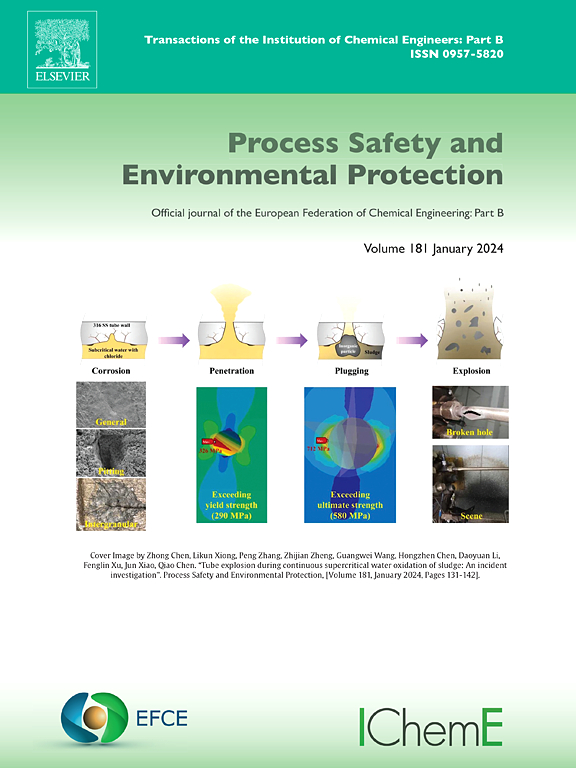伊拉克shat Al-Hillah河沉积物中的多环芳烃:时空分布、污染源、人类影响及治理策略
IF 6.9
2区 环境科学与生态学
Q1 ENGINEERING, CHEMICAL
引用次数: 0
摘要
本研究调查了伊拉克巴比伦市Shatt Al-Hillah河沉积物中16种重点多环芳烃(PAHs)的时空分布、来源和人类健康风险。多环芳烃含量在1713.29 ~ 9996.47 ng/g干重范围内,以高分子量多环芳烃(五环和六环化合物)为主。分子诊断比和主成分分析表明,多环芳烃的主要来源是热源和岩源混合排放,包括汽车尾气、工业排放和生物质燃烧。在所有采样点和所有季节,成人和儿童的终生癌症风险增量(ILCR)值都超过了1 × 10⁻⁴的可接受阈值,表明有显著的致癌风险。使用Triton X-100对沉积物进行洗涤,然后用麦秸活性炭(AC)处理洗涤出水,PAHs去除率在74.87 %和94.43 %之间。AC在三个循环中表现出很高的可重复使用性。这些发现突出了环境管理战略的迫切需要,并证明了利用农业废物来源的AC作为修复多环芳烃污染沉积物的有效、低成本和可持续解决方案的潜力。本文章由计算机程序翻译,如有差异,请以英文原文为准。
PAHs in the sediments of the Shatt Al-Hillah River, Babylon, Iraq: Spatial and temporal distribution, pollution sources, human impacts, and treatment strategy
This study investigated the spatial and temporal distribution, sources, and human health risks of 16 priority polycyclic aromatic hydrocarbons (PAHs) in the sediments of the Shatt Al-Hillah River, Babylon, Iraq. The concentrations of PAHs ranged from 1713.29 to 9996.47 ng/g dry weight, with high molecular weight PAHs (five- and six-ring compounds) dominating across all seasons. Molecular diagnostic ratios and principal component analysis revealed that the primary sources of PAHs were mixed pyrogenic and petrogenic emissions, including vehicular exhaust, industrial discharges, and biomass combustion. The Incremental Lifetime Cancer Risk (ILCR) values for adults and children at all sampling sites and during all seasons exceeded the acceptable threshold of 1 × 10⁻⁴, indicating a significant carcinogenic risk. Sediment washing using Triton X-100 followed by treatment of the washing effluent with activated carbon (AC) derived from wheat straw achieved PAHs removal efficiencies between 74.87 % and 94.43 %. The AC exhibited high reusability across three cycles. These findings highlight the urgent need for environmental management strategies and demonstrate the potential of using agricultural waste-derived AC as an effective, low-cost, and sustainable solution for remediating PAH-contaminated sediments.
求助全文
通过发布文献求助,成功后即可免费获取论文全文。
去求助
来源期刊

Process Safety and Environmental Protection
环境科学-工程:化工
CiteScore
11.40
自引率
15.40%
发文量
929
审稿时长
8.0 months
期刊介绍:
The Process Safety and Environmental Protection (PSEP) journal is a leading international publication that focuses on the publication of high-quality, original research papers in the field of engineering, specifically those related to the safety of industrial processes and environmental protection. The journal encourages submissions that present new developments in safety and environmental aspects, particularly those that show how research findings can be applied in process engineering design and practice.
PSEP is particularly interested in research that brings fresh perspectives to established engineering principles, identifies unsolved problems, or suggests directions for future research. The journal also values contributions that push the boundaries of traditional engineering and welcomes multidisciplinary papers.
PSEP's articles are abstracted and indexed by a range of databases and services, which helps to ensure that the journal's research is accessible and recognized in the academic and professional communities. These databases include ANTE, Chemical Abstracts, Chemical Hazards in Industry, Current Contents, Elsevier Engineering Information database, Pascal Francis, Web of Science, Scopus, Engineering Information Database EnCompass LIT (Elsevier), and INSPEC. This wide coverage facilitates the dissemination of the journal's content to a global audience interested in process safety and environmental engineering.
 求助内容:
求助内容: 应助结果提醒方式:
应助结果提醒方式:


